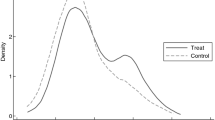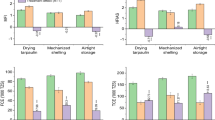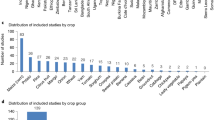Abstract
Reduction of post-harvest loss (PHL) can play an important role in complementing efforts to address food security challenges. This paper used data from 390 small-scale maize farmers in Kilosa, Tanzania to analyse the impact of post-harvest management training and the supply of hermetic bags on food insecurity status in a framed field experiment setting with two treatments. In the first treatment group, farmers were trained on post-harvest management, and in the second treatment they were given the same training as the first treatment group and were, in addition, provided with hermetic bags for storing maize. Our estimations show that the interventions had an impact in reducing maize PHL and household food insecurity. The intervention combining training and supply of hermetic bags abated maize PHL by 53%, whereas the training intervention alone abated PHL by 26%. Further, the intervention combining training and supply of hermetic bags reduced the household food insecurity access scale (HFIAS) score by 30.9% while the training intervention alone reduced it by 10.8% relative to the control group. The two interventions also lowered the probability of treated households experiencing moderate or severe food insecurity, and increased the probability of households being food secure or mildly insecure relative to the control group. Notably, the intervention which combined training and supply of hermetic bags had a significantly larger impact compared to the one providing training only. These results imply that more investment should be done on interventions to reduce PHL to complement efforts to improve food security. They also point to possible affordable interventions to reduce maize PHL and the importance of supplying material support in addition to training to minimize PHL and improve food security in Tanzania.




Similar content being viewed by others

References
Abass, A. B., Ndunguru, G. I., Mamiro, P., Alenkhe, B., Mlingi, N., & M. Bekunda M. (2014). Post-harvest food losses in a maize-based farming system of semi-arid savannah area of Tanzania. Journal of Stored Products Research, 57, 49–57.
African Post-Harvest Losses Information System. (2020). Dry weight loss (%): Tanzania - All crops - All years. https://www.aphlis.net/en/data/dry-weight-losses/africa/Tanzania/all-provinces/all-crops/all-years?metric=prc#/. Accessed 15 April 2020.
Aggarwal, S., Francis, E., & Robinson, J. (2018). Grain today, gain tomorrow: Evidence from a storage experiment with savings clubs in Kenya. Journal of Development Economics, 134, 1–15.
AGRA/ Alliance for a Green Revolution in Africa. (2013). Establishing the status of post-harvest losses and storage for major staple crops in eleven African countries (phase I). AGRA: Nairobi, Kenya.
Aulakh, J. & Regmi, A. (2013). Post-harvest Food Losses Estimation - Development of Consistent Methodology. Presented at the Agricultural & Applied Economics Associations 2013, AAEA & CAES Joint Annual Meeting, Washington DC, USA, 4–6 August 2013. http://www.fao.org/fileadmin/templates/ess/documents/meetings_and_workshops/GS_SAC_2013/Improving_methods_for_estimating_post_harvest_losses/Final_PHLs_Estimation_6-13-13.pdf. Accessed on 16 April 2020.
Barrett, C. B. (2002). Food security and food assistance programs. In B. Gardner and G. Rausser (eds): Handbook of Agricultural Economics (Chapter 40), volume 2.
Basu, K., & Wong, M. (2015). Evaluating seasonal food storage and credit programs in East Indonesia. Journal of Development Economics, 115, 200–216.
Bertrand, M., Duflo, E., & Mullainathan, S. (2004). How much should we trust differences-in-differences estimates? Quarterly Journal of Economics, 119(1), 249–275.
Bokusheva, R., Finger, R., Fischler, M., Berlin, R., Marín, Y., Pérez, F., & Paiz, F. (2012). Factors determining the adoption and impact of a postharvest storage technology. Food Security, 4(2), 279–293.
Cameron, A. C., Gelbach, J. B., & Miller, D. L. (2008). Bootstrap-based improvements for inference with clustered errors. The Review of Economics and Statistics, 90(3), 414–427.
Chegere, M. J. (2018). Post-harvest loss reduction by small-scale maize farmers: The role of handling practices. Food Policy, 77, 103–115.
Chegere M. J., Eggert, H., & Söderbom M. (in press). The effects of storage technology and training on Post-Harvest Losses, Practices and Sales: Evidence from Small-Scale Farms in Tanzania. Economic Development and Cultural Change.
Coates, J., Swindale, A. & Bilinsky, P. (2007). Household Food Insecurity Access Scale (HFIAS) for Measurement of Household Food Access: Indicator Guide (v. 3). Washington, D.C.: FHI 360/FANTA.
Costa, S. J. (2014). Reducing food losses in sub-Saharan Africa (improving post-harvest management and storage technologies of smallholder farmers). Kampala, Uganda: UN World Food Programme.
De Groote, H., Narrod, C., Kimenju, S. C., Bett, C., Scott, R. P., Tiongco, M. M., & Gitonga, Z. M. (2016). Measuring rural consumers’ willingness to pay for quality labels using experimental auctions: The case of aflatoxin-free maize in Kenya. Agricultural Economics, 47(1), 33–45.
ESRF/ Economic and Social Research Foundation. (2013). Tanzania Markets Pan; Policies That Work 4 Markets; Post-Harvest Losses in Tanzania: Challenges and Options for Mitigation; Policy Brief no 3-ENG / 2013.
FAO. (1980). Assessment and collection of data on post-harvest food grain losses, FAO Economic and Social Development Paper 13. Rome, Italy.
FAO. (2008). Household metal Silo: Key allies in FAO’s fight against hunger. Rome: FAO.
FAO. (2013). The state of food insecurity in the world. Rome: FAO.
FAO and WHO. (2016). Pesticide residues in food 2016 Report. 2016 Special session of the joint FAO/WHO meeting on pesticide residues; FAO Plant Production and Protection Paper 227, FAO and WHO. Rome, Italy.
FAO and World Bank. (2010). FAO/World Bank workshop on reducing post-harvest losses in grain supply chains in Africa. FAO. Rome, Italy.
Farrell, G., & Schulten, G. (2002). Larger grain borer in Africa: A history of efforts to limit its impact. Integrated Pest Management Review, 7, 67–84.
Feder, G., Murgai, R., & Quizon, J. B. (2004). The acquisition and diffusion of knowledge: The case of pest management training in farmer field schools, Indonesia. Journal of Agricultural Economics, 55(2), 221–243.
Gabriel, A. & Hundie, B. (2006). Farmers’ post-harvest grain management choices under liquidity constraints and impending risks: Implications for achieving food security objectives in Ethiopia. In: International Association of Agricultural Economists, Gold Goast, Australia, August 12–18, 2006, pp. 1–17.
Gitonga, Z. M., De Groote, H., Kassie, M., & Tefera, T. (2013). Impact of metal silos on households’ maize storage, storage losses and food security: An application of a propensity score matching. Food Policy, 43, 44–55.
Hanjra Munir A., Ferede T., Blackwell J., Jackson T. M. & Abbas A. (2013). Global food security: facts, issues, interventions and public policy implications. In Hanjra, Munir A. (Ed.). Global food security: emerging issues and economic implications. New York, NY, USA: Nova Science Publishers. pp.1–35. (Global Agriculture Developments).
Hasan, M. K., Desiere, S., D’Haese, M., & Kumar, L. (2018). Impact of climate-smart agriculture adoption on the food security of coastal farmers in Bangladesh. Food Security, 10(4), 1073–1088.
Hodges, R. J., & Stathers, T. E. (2013). Facing the food crisis: How Africa smallholder can reduce posthaverst cereal losses by supplying better quality grain. Outlooks Pest Management, 24(5), 217–221.
Hodges, R. J., Buzby, J. C., & Bennett, B. (2011). Postharvest losses and waste in developed and less developed countries: Opportunities to improve resource use. Journal of Agricultural Science, 149, 37–45.
Kadjo, D., Ricker-Gilbert, J., & Alexander, C. (2016). Estimating price discounts for low-quality maize in sub-Saharan Africa: Evidence from Benin. World Development, 77, 115–128.
Kadjo, D., Ricker-Gilbert, J., Abdoulaye, T., Shively, G., & Baco, M. N. (2018). Storage losses, liquidity constraints, and maize storage decisions in Benin. Agricultural Economics, 49(4), 435–454.
Kajembe, G.C., Dos Santos, A.S., Mwakalobo, A.B., & Mutabazi, K. (2013). The Kilosa district REDD+ pilot project, Tanzania A socioeconomic baseline study. International Institute for Environment and Development, London.
Kaminski, J., & Christiaensen, L. (2014). Post-harvest loss in sub-Saharan Africa—What do farmers say? Global Food Security, 3, 149–158.
Kumari, B. R., Rao, G. R., Sahrawat, K. L., & Rajasekhar, P. (2012). Occurrence of insecticide residues in selected crops and natural resources. Bulletin of Environmental Contamination and Toxicology, 89(1), 187–192.
Meikle, W. G., Markham, R. H., Nansen, C., Holst, N., Degbey, P., Azoma, K., & Korie, S. (2002). Pest management in traditional maize stores in West Africa: A farmer’s perspective. Journal of Economic Entomology, 95(5), 1079–1088.
Mutz, D., & Pemantle, R. (2012). The perils of randomization checks in the analysis of experiments. 1-25. Department Papers (ASC) 742, University of Pennsylvania. https://repository.upenn.edu/asc_papers/742
Ndegwa, M. K., De Groote, H., Gitonga, Z. M., & Bruce, A. Y. (2016). Effectiveness and economics of hermetic bags for maize storage: Results of a randomized controlled trial in Kenya. Crop Protection, 90, 17–26.
Pieters, H., Guariso, A., & Vandeplas, A. (2013). Conceptual framework for the analysis of the determinants of food and nutrition security. FOODSECURE Working paper no. 13.
Sheahan, M., & Barrett, C. B. (2017). Food loss and waste in sub-Saharan Africa: A critical review. Food Policy, 70, 1–12.
Shee, A., Mayanja, S., Simba, E., Stathers, T., Bechoff, A., & Bennett, B. (2019). Determinants of postharvest losses along smallholder producers maize and sweetpotato value chains: An ordered Probit analysis. Food Security, 11(5), 1101–1120.
Snapp, S. S., & Fisher, M. (2015). “Filling the maize basket” supports crop diversity and quality of household diet in Malawi. Food Security, 7(1), 83–96.
Stathers, T., Lamboll, R., & Mvumi, B. M. (2013). Postharvest agriculture in changing climates: Its importance to African smallholder farmers. Food Security, 5(3), 361–392.
Tanzania National Bureau of Statistics (TNBS) (2012). National Sample Census of Agriculture Small Holder Agriculture Volume II: Crop Sector – National Report, NBS, Tanzania.
Tefera, T., Kanampiu, F., De Groote, H., Hellin, J., Mugo, S., Kimenju, S., & Banziger, M. (2011). The metal silo: An effective grain storage technology for reducing post-harvest insect and pathogen losses in maize while improving smallholder farmers’ food security in developing countries. Crop Protection, 30(3), 240–245.
Tesfaye, W., & Tirivayi, N. (2018). The impacts of postharvest storage innovations on food security and welfare in Ethiopia. Food Policy, 75, 52–67.
Tuholske, C., Andam, K., Blekking, J., Evans, T., & Caylor, K. (2020). Comparing measures of urban food security in Accra, Ghana. Food Security, 12, 417–431. https://doi.org/10.1007/s12571-020-01011-4.
World Bank. (2011). Missing Food: The Case of Post-harvest Grain Losses in Sub-Saharan Africa, report no, 60371-AFR. Washington, D.C.: The World Bank.
Young, A. (2019). Channeling Fisher: Randomization tests and the statistical insignificance of seemingly significant experimental results. Quarterly Journal of Economics, 134(2), 557–598.
Acknowledgements
We gratefully acknowledge financial support from the Swedish International Development Cooperation Agency (SIDA). We would also like to thank A to Z Textile Mills Ltd., who generously provided hermetic bags for the intervention and Pee Pee Tanzania Ltd., for providing their expertise in the use of hermetic bags. Inputs from Håkan Eggert and Måns Söderbom in the initial stages of this work are highly appreciated and acknowledged.
Author information
Authors and Affiliations
Corresponding author
Ethics declarations
Conflict of interest
The authors declare that they have no conflict of interest.
Rights and permissions
About this article
Cite this article
Chegere, M.J., Lokina, R. & Mwakaje, A.G. The impact of hermetic storage bag supply and training on food security in Tanzania. Food Sec. 12, 1299–1316 (2020). https://doi.org/10.1007/s12571-020-01052-9
Received:
Accepted:
Published:
Issue Date:
DOI: https://doi.org/10.1007/s12571-020-01052-9



